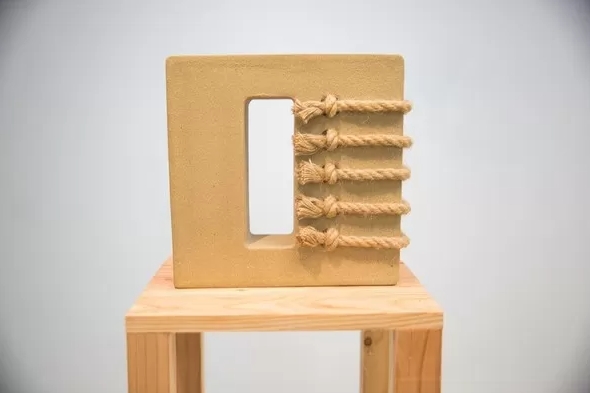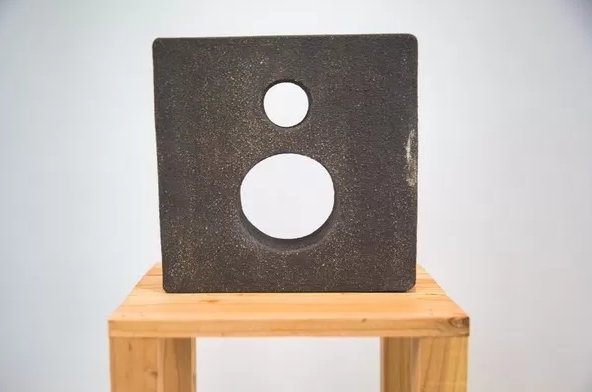

4C 艺术家专访 | 对话张亮,寻找传统陶瓷与当代艺术的完美
发布日期:2023-08-14 17:56:00 浏览次数:次

张亮 (Liang Zhang) ,当代艺术家,现生活和创作于洛杉矶,于2015年获得华盛顿大学跨学科视觉艺术学士学位,2018年于洛杉矶奥蒂斯艺术与设计学院获得美术硕士学位。是“2019年LA Artcore第5届年度评选展”第一名获得者,在2022年获得“第21届日本国际艺术交流展览”的荣誉提名,并在2020年和2023年分别获得了Grey Cube Gallery的“黑与白”展的荣誉提名和优异奖。其作品曾在美国、意大利、奥地利、德国和日本展出。
Liang Zhang is a contemporary artist who currently lives and works in Los Angeles. She obtained a Bachelor's degree in Interdisciplinary Visual Arts from the University of Washington in 2015 and a Master's degree in Fine Arts from Otis College of Art and Design in 2018. Zhang was the first-place winner of the "5th Annual Juried Exhibition" by LA Artcore in 2019. She received an Honorable Mention at the "21st Japan International Art Exchange Exhibition" in 2022 and received Honorable Mentions and Excellence Awards at Grey Cube Gallery's "Black and White" exhibitions in 2020 and 2023. Liang Zhang's works have been exhibited in the United States, Italy, Austria, Germany, and Japan.
张亮的艺术创作主要是以雕塑和装置为媒介,通过对陶土、绵绳、软毛、链条等材料的特殊处理,探索如何在有限的世界里寻找无限的突破。同时自然与人类之间相互作用的关系是张亮一直在研究的议题。自然设立条条框框,各种枷锁,而人类在大大小小的规则中尝试不同的可能。她的雕塑作品常常运用离奇而引人入胜的材料搭配组合,唤醒观众对于当代社会中强加的约束和无法控制的混乱之间的微妙平衡的思考。
Liang Zhang's art mainly utilizes sculpture and installation as media. Through special treatments of materials such as clay, ropes, soft fur, and chains, she explores how to find infinite breakthroughs in a limited world. The interaction between nature and humanity is a recurring theme in Zhang's research. Nature sets boundaries and various constraints, while humanity explores different possibilities within these rules. Her sculpture works often combine intriguing and captivating materials, evoking contemplation on the delicate balance between imposed constraints and uncontrollable chaos in contemporary society.

此次张亮个展命名为融合之境(Converging Realms),并于2023年7月27日在美国洛杉矶4C Gallery开幕,展览甄选了其近些年来的代表之作,通过作品及作品之间的组合关系,我们将共同感受到艺术家所传达的创作观念及艺术理念。“对话张亮”从字里行间中,更加立体的呈现艺术家最真实的创作初源。
Zhang Liang’solo exhibition opened on 27th. July 2023 at the 4C Gallery in Los Angeles, is called 'Converting Realms' . The exhibition selected her representative works from recent years. Through the combination relationship between works, we will jointly experience the creative concepts and artistic concepts conveyed by the artists. The "dialogue with Zhang Liang" presents the artist's most authentic creative origins in a more three-dimensional manner between the lines.

对话张亮:
Q= 忻伊珊 Yishan Xin A= 张亮 Liang Zhang
Q:您是从什么时候开始接触艺术的?是什么让您喜欢艺术并坚持创作?
A:从出生起我们就被无意地暴露在艺术面前,小到家里的一件装饰,大到去美术馆欣赏各种艺术作品,艺术离不开生活,生活更离不开艺术。认真学习艺术是从大学开始,我选修并尝试了各种创作媒介和类别,例如版画、装订、平面设计、陶艺等,我总是能在其中找到无尽的乐趣。我喜欢看到我的想法从雏形逐渐成型,最终呈现为作品的过程。它们可以代表一部分的我,也属于我作为一个个体的历史。
Q: I’d like to begin by asking how did you come to art? What made you interested in art and kept you persevering in your creative pursuits?
A: From birth, we are inadvertently exposed to art, from the small decorations in our homes to visiting art galleries to appreciate various artworks. Art is inseparable from life, and life is intertwined with art. Serious study of art began for me in university, where I chose to explore and experiment with various creative mediums and categories, such as printmaking, bookbinding, graphic design, and ceramics. In each of these, I have always found endless enjoyment. I love witnessing my ideas gradually taking shape and eventually materializing into artworks. They represent a part of me and belong to my individual history.

Q:您将此次个展命名为融合之境(Converging Realms),能否谈谈其背后的含义?
A:“融合之境”强调的是有机与网格这两个独特部分的融合,并以此作为本次展览的核心。其中,“融合”一词暗示了这几对比元素的汇聚和交织。“境"指的是由有机和网格所代表的不同领域或范畴,它们具有独特的特征。“融合之境”强调了有机和网格之间的相互联系和相互作用,将它们描绘成动态而交织的力量。我希望通过这次展览深入探讨这些领域,并探索其中的内在复杂性。
Q: The title of your solo exhibition is "Converging Realms”. Could you please talk about the meaning behind it?
A: The exhibition “Converging Realms" centers around the amalgamation of two distinct elements: organic and grid. The "converging" implies the interweaving of these contrasting elements; and "realm" refers to the different domains or categories represented by the organic and grid, each with its unique characteristics. “Converging Realms" emphasizes the interconnectedness and interaction between the organic and grid, portraying them as dynamic and intertwined forces. Through this exhibition, I hope to delve into these realms and explore their inherent complexities.

Unglazed ceramic, faux fur, and cotton piping cord
Q:此次展出的作品均为雕塑和装置作品。对于您而言,它们与绘画相比,有哪些独特之处?您为什么更倾向于这类立体生动的表达方式?
A:对于绘画和3D作品而言,我更倾向于后者。这是基于两个方面的考虑:首先,作为一个立体的人,我所看到和感受到的世界也是立体的。因此,我希望我的创作能保留这种立体的特性,这样可以用更简单直接的方式了解和解读我的作品。其次,我的作品源于我个人,为我表达,与我对话,所以我希望它也是跟我一样的,立体的。
Q: The works exhibited this time are all sculptures and installations. For you, what are the unique aspects of creating sculptures and installations compared to painting? Why do you prefer this three-dimensional and dynamic form of expression?
A: Regarding painting and 3D works, I lean towards the latter. Firstly, as a three-dimensional individual, I perceive and experience the world in three dimensions. Therefore, I want my creations to retain this three-dimensional quality, allowing for a more straightforward and direct understanding and interpretation of my work. Secondly, my artworks stem from my personal expression and dialogue with myself, so I want them to be akin to me, three-dimensional and multi-faceted.

Unglazed ceramic and cotton piping cord
Q:您的作品中主要以陶土为材料进行创作。 陶土通常用于制作各种工具和容器,然而在您的作品中,您将传统的陶瓷工艺与当代艺术元素相结合,将功能性的陶瓷转变为非功能性。您能分享一下是什么促使您对陶土这类材料产生进行实验与转化的兴趣?借由它,您试图传达怎样一种有关生命的思考?
A:陶土作为一种有丰富历史和传统的材料,被广泛应用于制作各种工具和容器。然而,在我的创作中,我追求将传统的陶瓷工艺与当代艺术元素相结合,将功能性的陶瓷转变为非功能性的艺术品。在我看来,陶土本身就蕴含着生命的能量和变化的本质。通过对陶土的塑造和加工,我试图模拟生命的成长和变迁,借此传达有关生命的深刻思考。我的作品探索了自然界中生命的多样性和复杂性。通过陶土这个材料,我尝试创造有机、流动的形态,同时加入当代艺术元素,突破传统陶瓷的功能性限制,使它们成为独立的艺术品。通过这样的转化,我希望观众可以感受到生命的生机和变化,以及生命体与自然环境之间的紧密联系。

Unglazed ceramic and cotton piping cord
Q: Your works primarily use materials like clay for the creative process. Clay is traditionally used for making various tools and containers, but in your works, you combine traditional ceramic techniques with contemporary art elements, transforming functional ceramics into non-functional pieces. Could you share what motivated you to experiment with and transform materials like clay? Through it, what kind of contemplation about life are you trying to convey?
A: As for ceramics, it is a material with a rich history and tradition widely used for creating various tools and vessels. However, in my creative process, I aim to blend traditional ceramic craftsmanship with contemporary art elements, transforming functional ceramics into non-functional art pieces. To me, clay embodies the essence of life's energy and constant change. Through the shaping and processing of clay, I strive to simulate the growth and transformation of life, conveying profound reflections on life. My artworks explore the diversity and complexity of life in the natural world. Using clay as the medium, I attempt to create organic and fluid forms while infusing contemporary art elements, breaking away from the functional constraints of traditional ceramics and transforming them into standalone art pieces. Through this transformation, I hope the audience can feel the vitality and metamorphosis of life and the close connection between living beings and the natural environment.

Unglazed ceramic, faux fur and zipper
Q:您的作品探讨了身体和心灵,有机和人工,控制和失控之间的对比关系。在创作过程中,哪些部分是刻意的控制,哪些部分是偶然尝试的结果?
A:刻意控制的部分主要涉及测量和切割,而偶然部分在于陶瓷部分(喻社会/世界)中的柔软的材料(喻人)的特性。制作过程中我会使用各种测量工具标记需要从泥片中切割的部分,尽管测量方法完全相同,但由于我可能存在一点点角度偏差,切割出来的部分可能与每一个部分不完全一样。很多时候,肉眼很难分辨这些微小的差异。在这个过程中,我也把人的因素掺杂进去,从而使作品更丰富饱满。另一方面,配件部分虽然也严格按照一定规律组装到陶瓷部分上,但由于其可变性和自由性,我有更多选择和发挥的空间。
Q: Your works explore the contrasting relationships between the body and the mind, organic and artificial, control and chaos. In the creative process, which parts are intentionally controlled, and which parts are the result of accidental experimentation?
A: The intentional control in my process mainly involves measuring and cutting, while the chaos aspect lies in the characteristics of the pliable material (representing society/world) in the ceramic parts (representing people). During the making process, I use various measuring tools to mark the sections that need to be cut from the clay slabs. Even though the measurement methods are consistent, due to slight angle variations, the cut pieces may not be identical for each part. Often, these tiny differences are hard to distinguish with the naked eye. In this process, I also incorporate human factors, making the artworks more rich and full. While the accessory parts are assembled onto the ceramic parts following a certain pattern, their variability and freedom provide me with more choices and room for expression.

Q:您的作品乍一看是静态的,但是仔细观察不难发现其中线绳的缠绕、捆绑、垂荡,使得作品呈现出了某种特殊的张力、收缩性和流动性。您希望观众从这一系列作品中获得怎样的对与人类与自然之间错综复杂关系的见解?
A:通过线绳的形态和构造,我试图表达人类与自然之间相互依存的紧密联系。线绳的交织和缠绕象征着我们与自然环境的纠缠,揭示了我们与自然之间的关系是如此紧密且不可分割。这些线绳形成的结构和张力代表着我们与自然界之间的相互作用,凸显了我们在这个错综复杂的关系中相互塑造和影响。
Q: Although your sculpture works may appear static at first glance, careful observation reveals the entanglement, binding, and dangling of these threads, creating a unique tension, contraction, and fluidity in the pieces. What insights do you hope the audiences gain from this series of works regarding the intricate and complex relationship between humans and nature?
A: Through the forms and structures of the thread, I attempt to express the interdependence between humans and nature. The interweaving and entanglement of the threads symbolize our entwinement with the natural environment, revealing the inseparable and intimate relationship between us and nature. The structures and tensions created by these threads represent our interactions with the natural world, highlighting how we shape and influence each other in this intricate relationship.

Clay
Q:最后想请您谈一谈展厅中央的这件作品“格子间”,不论大小,结构,展陈方式都与其余作品相比形成明显差异。请您分享一下您的创作意图和灵感来源。
A:这件作品是由很多大小相同的正方形泥片组成,它们是彼此依靠搭建而成的,表达着在固有的模式中暗自挣扎和对自由的向往。其中,一部分泥片被有规律地摆放,朝着窗户和门的方向逐渐散开,打破既有的存在规律。展厅的湿度和温度使每一个格子的水分蒸发变干,导致每一天它们的样子都不一样,它们本身也携带着来自这个空间的各种信息。随着时间的推移,这些格子联通的结构开始在自身内部散落倒塌,格子间里的生命逃脱出去,只留下一片废墟。
Q: Lastly, could you please talk about the artwork "Cubicle” displayed in the center of the gallery? It stands out from the rest in terms of size, structure, and presentation. Could you share your creative intentions and the inspiration behind it?
A: This artwork consists of many equally sized square clay pieces that are interdependent, expressing the struggle within inherent patterns and the longing for freedom. Some of the clay pieces are systematically arranged, gradually dispersing towards the direction of windows and doors, disrupting the existing pattern. The humidity and temperature of the exhibition hall cause the moisture in each grid to evaporate and dry, resulting in unique changes every day, carrying various information from the space itself. Over time, the interconnected structure of these grids starts to collapse and scatter within itself, allowing the life within the grids to escape, leaving behind a landscape of ruins.



结语:
当代艺术的一个重要特征便是边界的模糊性——异质媒介的挪用,多种形式的交汇,不同表现的杂糅。张亮的作品便是在中西、古今繁复的时空维度中,选取具有鲜明文化内涵的材质,进而呈现出的极具哲学性的想象力,使其具有视觉的独创性和含义的多样性。张亮将人造属性的材料与陶瓷材料相结合,从而使其艺术创作从以形体造型为核心的传统雕塑艺术,转为具有一定场域特性的装置空间艺术。陶瓷器皿的传统形态和功能被彻底剥离改变,隐喻地传达了关于有机体和⽹格系统相互作用,以及这些系统对个体产⽣的影响的哲理性关照与思考。她运用超乎想象的材料创作出独一无二的作品,不仅勾起人们对于这些作品的触碰欲,还使每位观者都能够在与她的雕塑装置作品接触的过程中找到自身的意义。
Conclusion:
One important characteristic of contemporary art is its ambiguity in boundaries, where different media are appropriated, various forms intersect, and diverse expressions are blended. Liang Zhang's works exemplify this by interweaving and projecting complex spatiotemporal dimensions from both Eastern and Western, ancient and modern cultural contexts. She uses materials with distinct cultural connotations to present highly imaginative, visually innovative, and conceptually diverse art pieces. Liang Zhang combines synthetic materials with ceramics, transforming her artistic creation from the traditional core of figurative sculpture to installation art with certain site-specific characteristics. The traditional form and function of ceramic vessels are completely stripped and altered, metaphorically conveying philosophical contemplation and reflection on the interactions between organisms and grid systems and the impacts these systems have on individuals. Through the use of extraordinary materials, Liang Zhang creates unique works of art that not only arouse people's desire to touch them but also allow each viewer to find their own meaning in the process of engaging with her sculpture and installation works.
文:忻伊珊 Yishan Xin
上一篇:陶瓷与布艺碰撞出的现代艺术作品
下一篇:音乐人李拓首次参与现代纯音乐制作